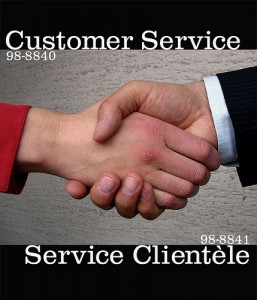Receiving positive feedback from your satisfied customers is always nice, but the real test of your business acumen lies in dealing with the upset ones. Unfortunately, despite efforts, mistakes happen. When they do, how you tackle them determines your success.
A talking customer is an opportunity
Let’s look at the opportunity. When the client is upset, she is willing to talk. And you have an opportunity to listen what she has got. Most likely, she has a genuine issue. If she had, you have every reason to alleviate the problem and see to it that the client is satisfied. Even assume, the client is being a little unreasonable. She wants a little more than what the implied promise is. That is an opportunity to show your customers that you mean what you say in your marketing materials. 🙂
Fix Your Processes
There’s another opportunity. An upset client is a symptom. Studies reveal that a small percentage of upset clients actually complain. It means that the clients are just a tip of an iceberg. Most likely, with every such disappointed client, there is a loose end in the process. If you do some soul searching, you will come up with some problem that you can fix and help you have more satisfied clients. I have learnt that it’s better to be prepared to listen to complaints. You never know what you might be missing out on unless you get critical feedback from them.
An upset customer might interact with an employee in person or on the phone. Remember, when a customer is upset, he or she might seem to lash out on you as a person. They can get unruly and sometimes downright obnoxious. Excepting the odd one out, most customers are looking for someone in your company to listen patiently and solve their problem in a reasonable time. Just give them a smile, hear them out and solve the problem they have. That is it! The first lesson is that you must listen to the customer.
Receive the Angst with Pleasure
There is no need to take the diatribe personally, I realised that the customer doesn’t know me as a person and his or her angst is not meant to be directed at me unless it is my fault. Keep your cool throughout the talk, and be professional and considerate when you respond. A lot of such customers might have a genuine problem and even though I agree that their tone might be far from polite, their complaint needs to be heard objectively. A brief heartfelt apology is a good start. An abusive and angry customer generally calms down to a great extent if you approach the issue with an open mind after an apology. If I got defensive I immediately came across as not trying to look at the problem from his or her perspective. Listen carefully without interrupting. Make sure that you register the complaint fully the first time itself, asking a customer to repeat the problem again will portray inattentiveness.
In case this conversation is happening on the phone, I make sure to note down the real problems which might not be obvious if the customer is irate. After taking down all the details, I offer to call the customer back at a time convenient for him or her. This gives you time to calmly resolve the problem while letting the customer cool down and will avoid the problem from exacerbating. I know that I have spent a considerable amount in acquiring the customer, so I need to make an effort to retain him or her.
I found myself empathizing with such customers and deviating from standard company policy in a few cases to help them out. Be ready to do so, dealing with people means that you cannot always follow a rigid set of rules. Give them the attention they deserve as individuals rather than a complaint. A company policy needs to be flexible since my customer takes priority over it.
Followup and Solve
Choose your words wisely. There are ways of replying in an effective manner without upsetting the customer further. Offer them the best you can; if that still doesn’t appease them, transfer the problem to a superior and brief them effectively about the issue. As a final point, always remember to follow up on the problem with the customer once it gets fixed. Satisfactorily dealing with upset customers will go a long way in ensuring the success of your venture.
So, what do you do when a customer calls in with a complaint?

About the author: Chaitanya Sagar is the Co-Founder and CEO of p2w2, an online marketplace for services like writing, software, graphic design, virtual assistance, business consulting and research. Chaitanya blogs at p2w2 blog
(RSS). He is fascinated by entrepreneurship and the difference technology can make in people’s lives.
Picture credits: Blatch Shermeee











